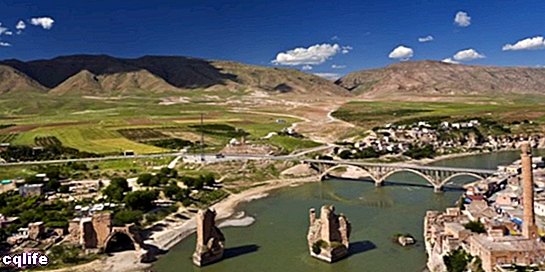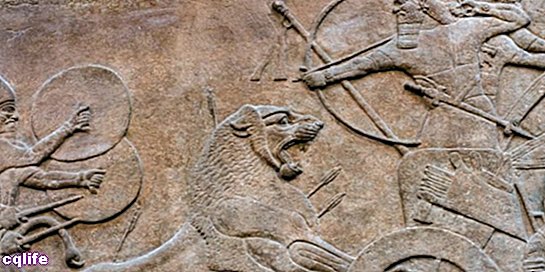- What is Mesopotamia?
- Location of Mesopotamia
- Major rivers of Mesopotamia
- Peoples of Mesopotamia
- Mesopotamian religion
- History of Mesopotamia
We explain what Mesopotamia is, its location, why it was important in ancient times and the peoples that inhabited it.

What is Mesopotamia?
Mesopotamia is a region of the Asia Occidental located between the Tigris and Euphrates rivers, as well as its surrounding lands. In this region arose during the Old age the so-called Mesopotamian civilization. Thanks to this culture, the Neolithic Revolution began there, that is, the developing of the farming and the cattle raising about 12,000 years ago.
The Mesopotamians served as a model and inspiration to the rest of the world and popularized fundamental inventions for human civilization such as the wheel, the cultivation of cereals, the development of cursive writing, the math and the astronomy.
Ancient Mesopotamia is an important reference in the study of human antiquity, since stories such as the myth of Gilgamesh, biblical episodes such as the universal flood, or the first set of laws known: the Hammurabi Code.
The different Mesopotamian peoples prospered culturally and were in their time one of the great civilizing poles of Eurasia, although centuries later they were little more than disputed territory of the great empires of late antiquity, such as the Roman Empire and the Persian Empire.
Its name comes from the Greek Μεσοποταμία which means "land between two rivers."
Location of Mesopotamia
Mesopotamian cultures settled where Iraq and Syria are today.The Mesopotamian region is in the Near East, extending over much of the territories current Iraq and Syria, and to a lesser extent in the vicinity of its borders with Kuwait, Iran and Turkey.
It encompasses a territory made up of four regional units: the plateaus of Upper Mesopotamia, the plains of Lower Mesopotamia, the moutains Y mountain ranges, and the steppes or desert regions.
Major rivers of Mesopotamia

As we have said, the main rivers of the region and to whom the emergence and prosperity of the Mesopotamian peoples were due are:
- Tigris. It has 1,850 km of length and it is the one with the greatest slope. Its unevenness from source to mouth is 1,150 meters. It has tributaries along its left side, such as the Armenia and the Zagros.
- Euphrates. It stretches for 2,800 km. Its unevenness is 4,500 meters. However, its slope is gentler for most of its journey. Its tributaries are the Taurus, the Balih and the Habur, which cross the ancient Mesopotamian territory and have different flows: the Habur is navigable almost all year round, while the Balih can become dry.
Both rivers suffer frequent floods, although not very beneficial, unlike those of the Nile (which are vital for the fertilization of the neighboring Egyptian lands). Furthermore, these floods often come in bad weather and have destructive results.
Peoples of Mesopotamia

The Mesopotamian region was formerly divided into nations from Assyria (to the north) and Babylon or Chaldea (to the south). The latter also included the towns of Acadia (upper part) and Sumeria (lower part).
Assyrians, Akkadians, and Sumerians ruled the region from around 3100 BC. Until 539 BC. It is estimated the writing was invented at the beginning of this period. The fall of Babylon, which meant the end of its power, was due to the conquest by the Archaemenid Empire or First Persian Empire.
- Sumerian culture. It was the first Mesopotamian nation, which founded the mythical cities of Uruk, Lagas, Kis, Ur and Eridu, with an economy based on irrigated agriculture. They were the inventors of cuneiform writing and ruled by absolute kings who were vicars of the gods in the Earth.
- Akkadian culture. The Akkadians were the result of the invasions of the Semitic peoples of the Arabian Peninsula, who were pursuing the prosperity of the Sumerians. Among them came Arabs, Hebrews, and Syrians, who settled north of Sumeria and eventually prospered enough to invade it and found the Akkadian Empire.
- Babylonian culture. The town of Babylon eventually begot his own culture, in two great historical periods: the first under the reign of King Hammurabi, in what is known as the Paleobabilónico Empire, famous for resisting the attacks of nomadic peoples and prospering enormously in its civil, cultural and military works. The second stage is known as the Babylonian Renaissance and follows the Assyrian rule, when a new Semitic tribe recast the Babylonian power: the Chaldeans. Under the rule of their most famous king, Nebuchadnezzar II, they founded an empire that extended to the shores of the Mediterranean.
- Assyrian culture. The Assyrians settled north of Babylon after Hammurabi's empire fell, and were soon strong enough to establish their own monarchy, with major cities such as Assur and Nineveh coming under attack from the Babylonians-Medes alliance. in 612 a. C.
Mesopotamian religion
The Babylonian peoples were highly religious, and almost every element of their society they were understood from the divine will. His conception of the world was limited to the surroundings of the region: the world was limited by mountains and an immensity of Water, and each god corresponded to certain kingdoms or domains.
The gods were immortal and eternal, capable of creating reality with the mere word. On the other hand, narrations of deaths and rebirths. Some of the main Mesopotamian gods were An (sky god), Enlil (wind god), Enki (water god), and Ninhursag (earth goddess).
However, each culture built its own pantheon of deities and its own version of the religion that they shared. The cultural fertility of the region was due to the constant arrival of nomadic peoples eager to settle and share Mesopotamian riches.
History of Mesopotamia
In the Pale Babylonian empire, the Hammurabi Code, the first code of laws, was created.The history of Mesopotamia goes from the prehistory and the settlement of the first nomads in the region, until the conquest of the Near East by the Persians.
- Origins. The first Mesopotamian agricultural communities arose around 7,000 BC. C., developing a simple agriculture, which was later improved by the Sumerian farmers using the Tigris and the Euphrates for irrigation, not depending on the rains. In this way the first permanent settlements in the region were born: Buqras, Umm Dabaghiyah and Yarim Tappeh, as well as the first Mesopotamian minor cultures: the Hassuna-Samarra (5,600-5,000 BC) and the Halaf (5,600-4,000 BC. C.).
- El Obeid period (5500-4000 BC). The foundation of the first settlements of terracotta buildings, called el-Obeid, and of the first ziggurats, buildings of religious veneration that would later be characteristic of the Mesopotamian civilization. The oldest of these temples would be Eridu, south of Sumeria.
- Uruk period (4,000-2,900 BC). This period begins with the emergence of the first city in history: Uruk, along with the first cuneiform written records and the appearance of the metal (copper, tin, bronze), and the wheel, which revolutionized transportation forever. This is the birth time of urban life.
- Archaic Dynastic Period (2,900-2,350 BC). It begins with the emergence of the first city-states, which competed with Uruk in importance, such as Ur and Kish, reaching populations between ten and fifty thousand inhabitants. It is a period of expansion of the techniques agriculture and the Sumerian way of life to the rest of the fertile Mesopotamian region, up to Syria. The construction of the first palaces and the first walls around the cities can only indicate that it was also a period of constant wars and political disputes, in which the cities of Uruk, Ur, Kish, Lagash and Umma contested the supremacy successively.
- Akkadian Empire (2,350-2,160 BC). This was the name of the Semitic dynasty that settled in Sumeria and conquered the cities under the rule of King Sargon I of Acadia. During his reign, Mesopotamia built exchange networks with the civilizations of the Indus Valley, Egypt, and Anatolia.
- Guti Period (2,150-2,100 BC). The Akkadian Empire succumbed during the reign of King Ur-Utu, as a result of internal tensions and invasions by the nomadic Guti and Lullubi peoples from the Zagros mountain range. The Gutis ruled briefly, making Lagash their political center, ruled by a man named Gudea, who did not accept the title of king and conducted a government peaceful and growing.
- III Dynasty of Ur (2110-2000 BC). Eventually the Gutis were expelled by the king of Uruk, Utu-Hegal, who would in turn be dethroned by Ur-Nammu, governor of Ur, who would reunify the territory and witness a Sumerian rebirth. This dynasty would culminate due to a process of political disintegration that between 2000 and 1800 a. Led to the dissolution of the Ur dynasty, in part due to the invasions of the Amurru or Amorites from the west.
- Pale Babylonian Empire (1800-1590 BC). The Amurru founded new Mesopotamian dynasties, and the Pale Babylonian Empire emerged from the hodgepodge. Its sixth king, Hammurabi, was noted for his flourishing rule in Arts Y Sciences, as well as military conquests; to such an extent that the region stopped being called Sumeria or Acadia to begin to be Babylon. The tongue Sumerian survived in written records, but was no longer spoken at the time, and new Amorite gods joined the Mesopotamian pantheon.
- Period of segregation (1590-1000 BC). The death of Hammurabi led to the weakening of Babylon and the invasions of the Kassite peoples, of enigmatic origins. These invaders founded new dynasties, thus founding Casita Babylon (1590-1160 BC), as they integrated with the local culture. They were followed by new Indo-European newcomers, who founded peripheral kingdoms in Mesopotamia, such as the Hittites, Hurritas, Peselet. Assyrians, whose origins are unknown, and whose territories initially came under Babylonian rule also gradually emerged.
- Neo-Assyrian Empire (1000-650 BC). After the year 900 a. C., the Assyrians expelled the Arameans from the region and took control of the Mesopotamian trade routes, under the mandate of the first neo-Assyrian king: Salmanaser III, who led them to expand their dominion over the entire Mesopotamia, Syria and Palestine. This expansion was followed by a period of enormous political conflict and internal and external strife, leading to War with Judah and Assyrian decline. Thus the Babylonian culture resurfaced, under the leadership of the Chaldean rebel Nabopolassar. The Assyrians were swept off the political map, their language erased, and their empire divided between the Medes and the Chaldeans.
- Neo-Babylonian Empire (612-539 BC). The Babylonians re-emerged in the region and flourished under the rule of Nabopolassar's son, the famous Nebuchadnezzar II, who conquered the kingdom of Judah and destroyed Jerusalem. However, he was later dethroned and replaced by King Nabonidus, considered a maddened king who could not cope with the conquest of Babylon by Cyrus the Great, Persian emperor, in 539 BC. Under the Persian rule the Mesopotamian civilization was put to an end.
